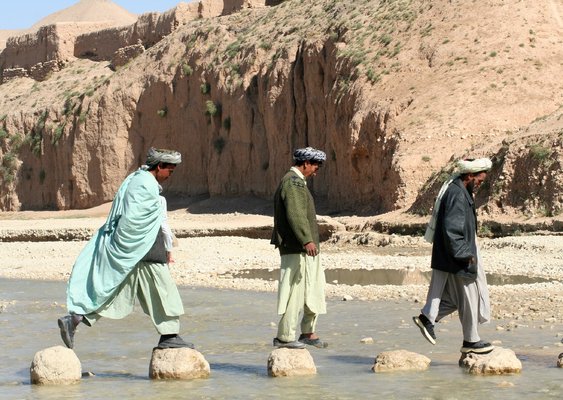
by Carolyn Gramling Thursday, January 5, 2012

Locals cross a stream in Faryab Province in northern Afghanistan. Kristin Enstad
Ravaged by war, drought and natural hazards such as earthquakes and landslides, Afghanistan’s people face many challenges. But the country also has untapped resources — great natural beauty , deep supplies of groundwater and a vast mineral wealth, including coal, gems like emeralds and metals like copper and iron.
For nearly 40 years — spanning the Cold War, Afghanistan’s own civil war and the U.S.-led invasion of the country in 2001 — U.S. Geological Survey scientists have worked with Afghan scientists to map and develop the country’s resources. Two stories in the most recent issue of EARTH magazine highlight the daunting challenges these scientists dealt with in the past and continue to face.
Geologist Jack Shroder began his career in Afghanistan in 1972, amassing satellite images and maps of the country. He also gathered seismic data weekly from the USGS’ Kabul University seismic station — which happened to record nuclear tests just north of the country’s border, in the then-USSR.
That got Shroder kicked out of the country in 1979, when the Soviets invaded. For the next decade, he worked with the radio program Voice of America to broadcast explanations to the Afghan people about their country’s frequent devastating earthquakes— as well as about Soviet exploitation of Afghan mineral resources. Schroder is now working with the U.S. military, teaching soldiers headed to Afghanistan about the country’s geology, natural hazards, environmental issues and declining water resources.
Afghanistan is also suffering under a decade-long drought — and ongoing war and shrinking glaciers make the situation even more dire. The country has water resources — groundwater fed by snowmelt and rainfall in the mountains — but lacks the technology and security to access them. Now, USGS scientists and the U.S. military are working with local scientists and engineers to adapt a thousands-year-old Afghan technology to access this deep water — and, hopefully, to help bring peace.
In the latest issue of EARTH, Jack Shroder tells his unique story, a first-person account of how he, the USGS and Afghanistan have been entwined over the last few decades. And writer David B. Williams describes the struggle to find clean water in this land-locked, water-starved country. Read more about efforts to rebuild Afghanistan in the July EARTH, on newsstands now.
© 2008-2021. All rights reserved. Any copying, redistribution or retransmission of any of the contents of this service without the expressed written permission of the American Geosciences Institute is expressly prohibited. Click here for all copyright requests.